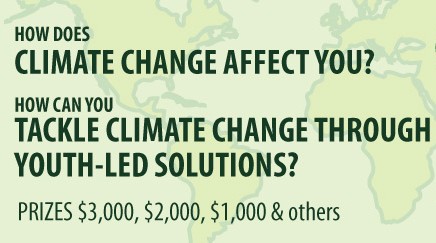International Essay Competition on Climate Change
WANTED: The Next Generation of ‘Green’ Entrepreneurs

The World Bank and its partners invite youth between the age of 18 and 25 years of age, to share their ideas on:
- How does climate change affect you?
How does climate change affect you, your country, town or local community? How do you think it will affect you in the future? Think about the consequences for employment, health, security and other areas of your life.
- How can you tackle climate change through youth-led solutions?
What can you do, working together with your peers, to address the problem of climate change in your country, town or local community? Think specifically about the role of youth-led initiatives in the ‘green economy’.
Climate change has been identified as one of the biggest global threats of our time. Scientists agree that global warming and extreme climate phenomena can be increasingly attributed to human activity – in particular, heavy emission of greenhouse gases, such as carbon dioxide, resulting from industrial processes.
Solutions to those pressing problems could lie in the rapidly growing ‘green economy’: environmentally sustainable enterprises, technological innovations (new sources of clean, renewable energy), energy efficiency measures, economic incentives for low-carbon choices etc. How can youth contribute?
Write your thoughts in an essay format, and (also) be eligibile to win a maximum prize of $3000! Submissions are now open, and this year for the first time the Essay Competition also invites the submission of short videos and photos!
Click here to apply! (Best of Luck)



guyzz..
climate..chnge is affcting oll…of us..n v oll..shuld..olso..b prtz of itzz solution..!!
so..mke..a strng..netwrk..of green crusaderz..2 bring a chnge..2 dis threat..
guyzz..
climate..chnge is affcting oll…of us..n v oll..shuld..olso..b prtz of itzz solution..!!
so..mke..a strng..netwrk..of green crusaderz..2 bring a chnge..2 dis threat..
Changes in climate, particularly increases in temperature, have already affected a diverse set of physical and biological systems in many parts of the world.
Examples of observed changes include shrinkage of glaciers, thawing of permafrost, later freezing and earlier break-up of ice on rivers and lakes, lengthening of mid- to high-latitude growing seasons, poleward and altitudinal shifts of plant and animal ranges, declines of some plant and animal populations, and earlier flowering of trees, emergence of insects, and egg-laying in birds.
General reduction in potential crop yields in most tropical and sub-tropical regions for most projected increases in temperature
Adaptation has the potential to reduce adverse impacts of climate change and to enhance beneficial impacts, but will incur costs and will not prevent all damages. Extremes, variability, and rates of change are all key features in addressing vulnerability and adaptation to climate change, not simply changes in average climate conditions. Human and natural systems will to some degree adapt autonomously to climate change. Planned adaptation can supplement autonomous adaptation, though options and incentives are greater for adaptation of human systems than for adaptation to protect natural systems.
Experience with adaptation to climate variability and extremes can be drawn upon to develop appropriate strategies for adapting to anticipated climate change. Adaptation to current climate variability and extremes often produces benefits as well as forming a basis for coping with future climate change. However, experience also demonstrates that there are constraints to achieving the full measure of potential adaptation. In addition, maladaptation, such as promoting development in risk-prone locations, can occur due to decisions based on short-term considerations, neglect of known climatic variability, imperfect foresight, insufficient information, and over-reliance on insurance mechanisms.